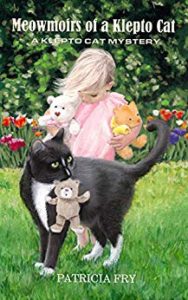 by Patricia Fry
by Patricia Fry
This article title comes from the most common question people ask when I mention that I’m writing a new book. I always stop and think about how to answer, because generating ideas has become second-nature to me.
By the time I finally settled into a freelance article-writing career, my brain brimmed with article ideas. You see, I’d prepared myself for nearly ten years to become a freelance writer. That groundwork included knowing how to come up with good ideas and understanding how to effectively use them. If you struggle with story ideas each time you sit down to write, I’m pretty sure my ideas for how to come up with good ideas will be enormously helpful to you.
First, a little of my background: I’ve been writing for publication since 1973, having published hundreds—maybe thousands—of articles in around 300 different magazines and newsletters. When I made the transition from nonfiction—give-me-the-facts-ma’am type writing—and began writing cozy mysteries, it wasn’t because I’d run out of ideas. My decision was more about a desire to shift gears and use a different part of my brain. I started my fiction journey in 2012, published my first Klepto Cat Mystery a year later, and I’m currently working on Book 31. That will make a total of 74 published books—thus the question from fans and curious bystanders, “Where do you get all of those ideas?” They also ask, “Are you afraid you’ll run out of ideas?”
Curiously, finding ideas is probably the easiest part in this fascinating career I’ve chosen. My head swims and overflows with ideas. There’s no writers-block syndrome going on here. I attribute this, at least partly, to my forty-year stint as a writer of nonfiction. As a freelance writer, my earnings depended on ideas and I learned how to find them, generate them, recycle them, and expand on them. That skill has helped in my fiction writing more than I ever imagined it would.
So where do my ideas come from?
1. I write about things I know and topics I want to know more about. Professionals advise you to write about what you know. You’ve heard it before, haven’t you? And believe me, it’s valid. When I was ready to begin my career, I already knew what I’d write about and which magazines I’d approach. At the time I was involved in horses and subscribed to several horse-related magazines. I studied every aspect of those magazines and I knew what their editors published and what their readers wanted. I also figured out what was missing, and I knew that, in order to break into these magazines, I needed to fill that void. Consequently, the first several articles I wrote were published. I used the same technique over and over throughout the years for a variety of publications.
I find that a healthy dose of curiosity is also useful for article-writers as well as novelists. When I stumble upon an interesting topic—something I want to know more about—I’ll research it and often work it into one of my stories.
2. I follow trends. What’s in the news or trending on the Internet? Sometimes it’s something worth writing about or including in a story. If it’s of interest to the public at large, surely some aspect or rendition of it will be of interest to your readers.
3. I pay attention to what’s going on around me. I watch what others are doing—how they approach life, manage their finances, face difficult situations, get things done (or not), cope with loss, celebrate, get along with others, and so forth. Everyone has a story. But what I find even more intriguing is the back story—the little side excursions, hilarious moments, successes, and missteps we all experience. While I don’t invade anyone’s privacy through my writing (without explicit permission), I might take a germ of an event or occurrence and create a wildly imaginary and unrecognizable scenario.
4. I love to eavesdrop. What are the people around me talking about? Many of my articles and a couple of my books resulted from one sentence; for example, something I overheard while waiting in line at the grocery store. I once met a woman in the post office who told me she was a handy-woman. Of course I interviewed her for an article.
 My book on long-distance grandparenting resulted from a tidbit I overheard one day. The woman said to her friend, “It really is difficult to connect and bond with your grandchildren when you live in another state.” Bingo. I knew there must be a way, and I did the research, used my imagination, and Liguori Publications produced my book, Creative Grandparenting Across the Miles.
My book on long-distance grandparenting resulted from a tidbit I overheard one day. The woman said to her friend, “It really is difficult to connect and bond with your grandchildren when you live in another state.” Bingo. I knew there must be a way, and I did the research, used my imagination, and Liguori Publications produced my book, Creative Grandparenting Across the Miles.
Here’s how I’ve used some of these techniques in my Klepto Cat Mysteries. I listen intently to the stories other people tell about their experiences with cats. It also helps that I write a daily blog featuring cats, so I’m constantly in research mode where cats are concerned. For example, Book One, Catnapped, was inspired by a true story one of my daughters told me about cats going missing in her neighborhood. In that story, I used some of her and her neighbors’ experiences and added a lot of fabrication.
Rags, the klepto cat in my mysteries, is for the most part fictional. However, I’ve patterned him loosely after my mother’s cat, Smokey (a half-Ragdoll cat that looks nothing like a Ragdoll), and my sweet Lily, a formerly feral tabby. I chose Smokey, not for his looks (sorry Smokey), but for his wonderful sense of confidence—the way he carries himself and the way he manages his kitty-cat life and those of his caretakers and visitors. Mama wanted a quiet snuggle cat that would stay inside the house with her all the time. What she got was a cat that certainly loves his lap time, but he’s a wanderer. He just has to be outside adventuring. Lily is the cat who carries things around in her mouth—her stuffed toys, mostly, and occasionally my slippers. So Rags, the klepto cat, is an interesting and humorous blend of these two purr-sonalities.
As I said, I do a lot of research and observing, but I also write what I know. I broke my foot some years ago and have stories of that struggle, so Aunt Margaret, aunt of the main human character, breaks her foot. I drive a Jeep Liberty and so does she. I’ve always wanted to live in a turn-of-the-century farmhouse, so I gave one to Savannah, the human star in my stories. And, since my life once revolved around horses, of course I brought a horse into the mix. When I heard a true story of a modern-day horse-rustling ring, I felt compelled to fabricate a story for my series and let Peaches (Savannah’s mare) lead the charge in search of the culprit.
Many of my ideas come from topics I covered while writing articles for magazines. One theme I’m particularly fond of is therapy animals. In Book Six, Celebrity Cat Caper, Rags acts as a therapy cat for a children’s reading program. Naturally, Rags finds enough trouble at the library to make a tantalizing story. Rags is also a therapy cat for pets at a veterinary clinic, where the starring veterinarian in the stories is giving free vet checks and treatment for dogs and cats living within the homeless community.
Seven years ago I created “Catscapades,” my daily cat blog, and I’m constantly looking for information, resources, and stories to post. This is another great way for an author to discover good story ideas. As I said, Smokey (my mom’s cat) is an adventurer and we often wonder where he goes during the day, who he encounters, if he has a relationship with other animals or people in the neighborhood. We’ve joked about tracking him with a GPS device. So when I did the research for a blog post about cats and dogs being fitted with tracking devices for various reasons, I thought that would make a good story. So in Book 19, The Amazing CATventure, Rags and a kitty-pal go on a journey that is tracked by GPS, for the readers’ amusement.
As you can see, ideas are not a problem. Ideas are everywhere; we just have to learn to become aware of them. Then there’s the next step—creating a tantalizing story around the theme or concept.
If you don’t know  Rags yet, let me tell you that he’s a sneaky, clever, gutsy guy. He doesn’t have a speaking part in the Klepto Cat Mysteries. And he doesn’t have a point of view. But he’s large and in charge throughout the stories. A beginning point for this series is, of course, Book One, Catnapped. Or, you can read Book 29, Meowmoirs of a Klepto Cat, and get a peek into Rags’s and his human family’s and friends’ unique and fascinating life. If you are familiar with the Klepto Cat Mysteries, this book includes never-before-told stories of Rags in his early years, as well as snippets from some of his more harrowing and interesting escapades.
Rags yet, let me tell you that he’s a sneaky, clever, gutsy guy. He doesn’t have a speaking part in the Klepto Cat Mysteries. And he doesn’t have a point of view. But he’s large and in charge throughout the stories. A beginning point for this series is, of course, Book One, Catnapped. Or, you can read Book 29, Meowmoirs of a Klepto Cat, and get a peek into Rags’s and his human family’s and friends’ unique and fascinating life. If you are familiar with the Klepto Cat Mysteries, this book includes never-before-told stories of Rags in his early years, as well as snippets from some of his more harrowing and interesting escapades.
Patricia Fry is the former executive director of WPN and the author of 72 published books. While most of her books are designed for authors, she now enjoys writing the Klepto Cat Mysteries—cozy mysteries with cats. Available in print and for your Kindle at Amazon.com.
